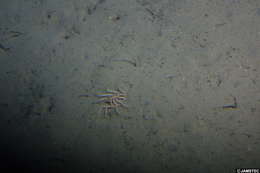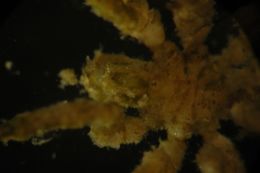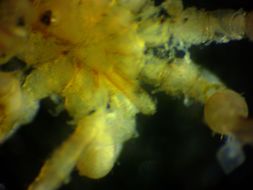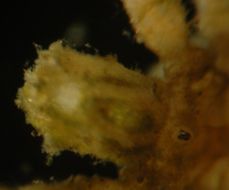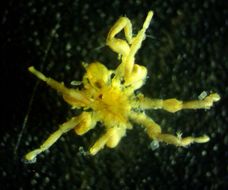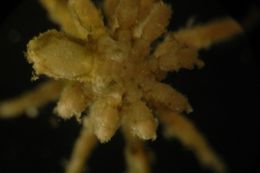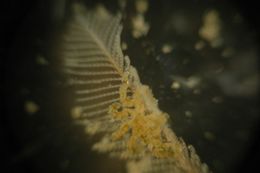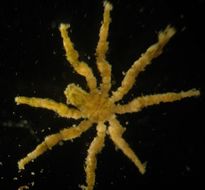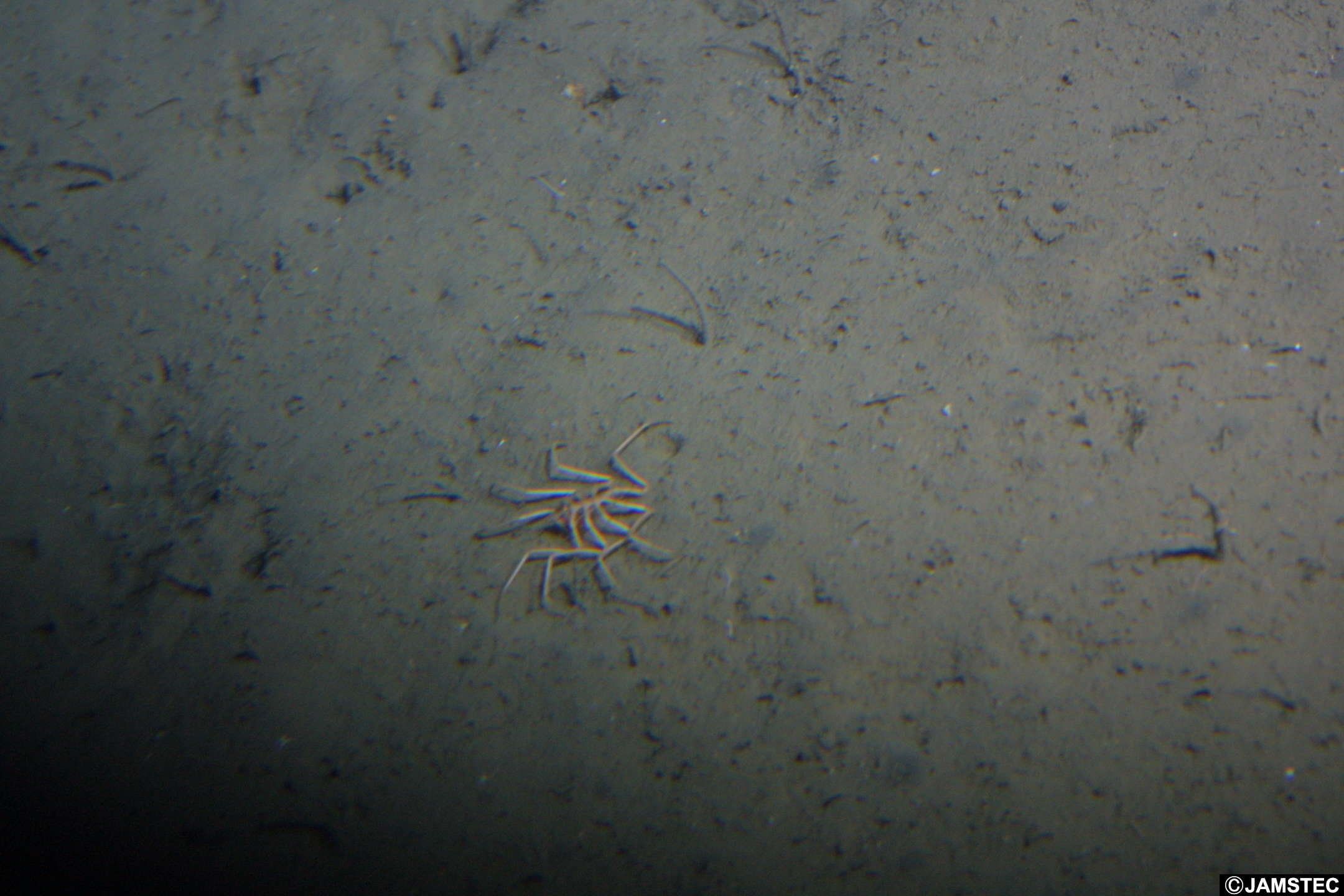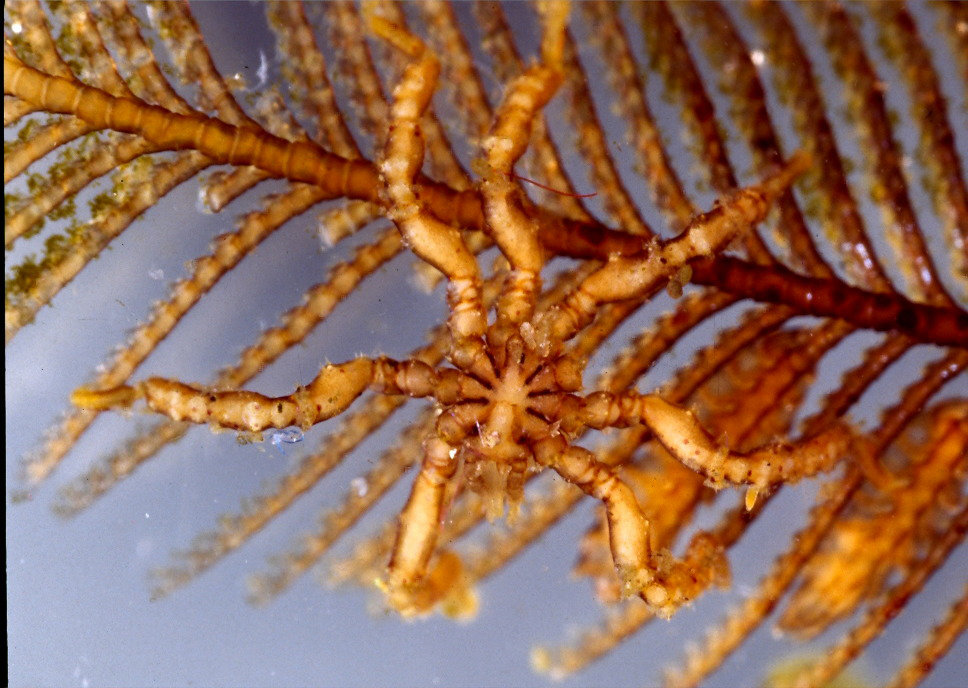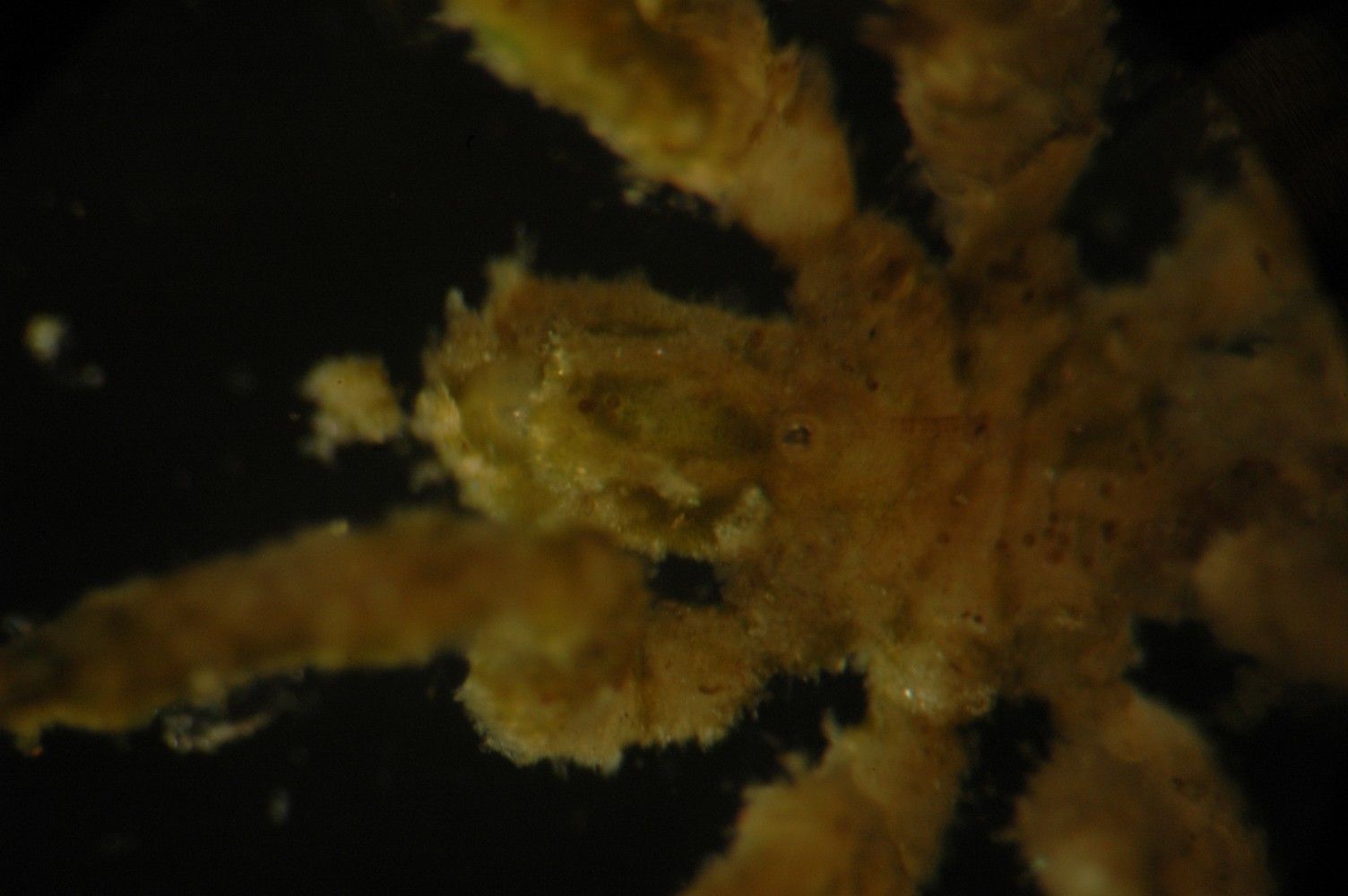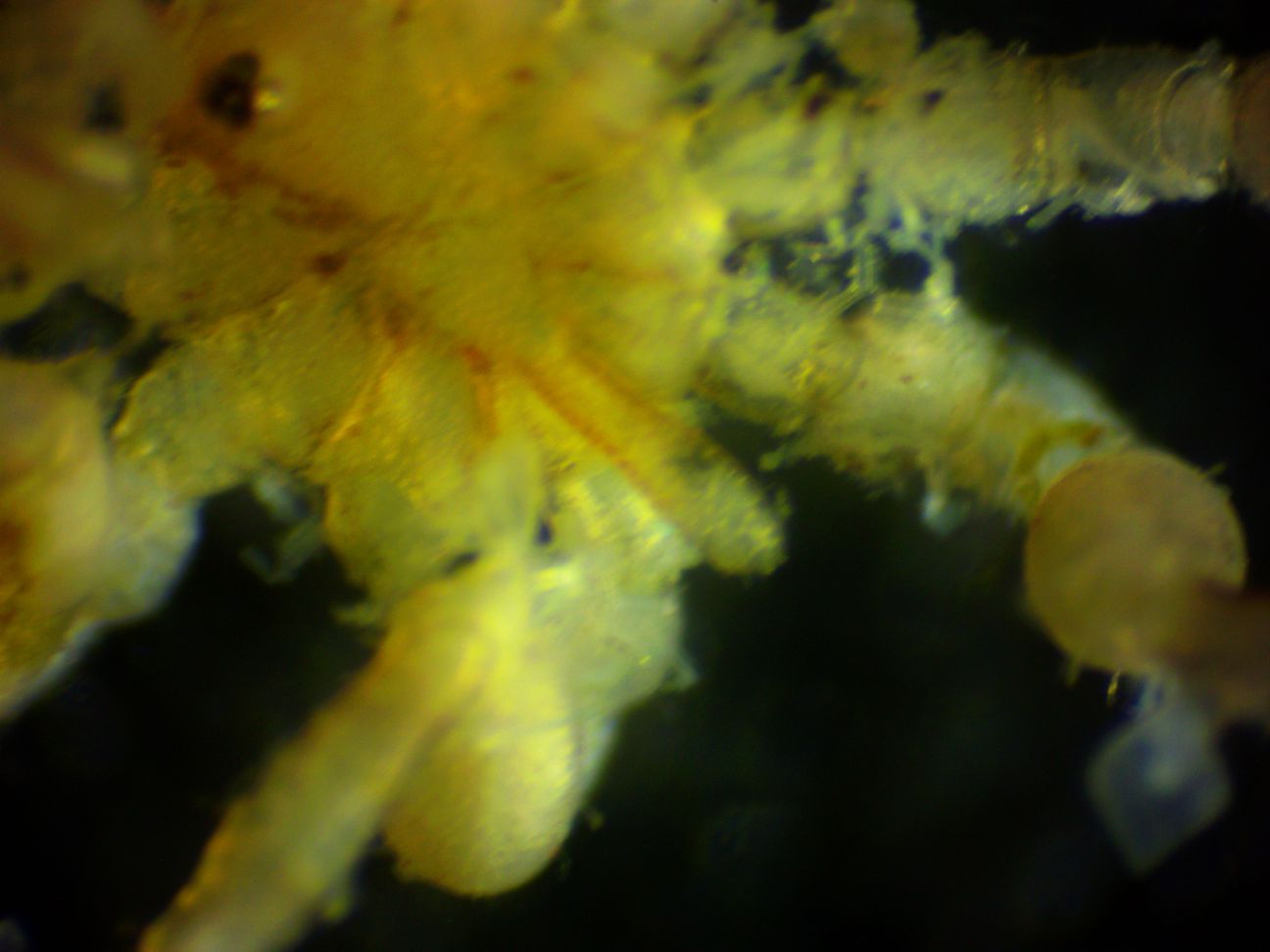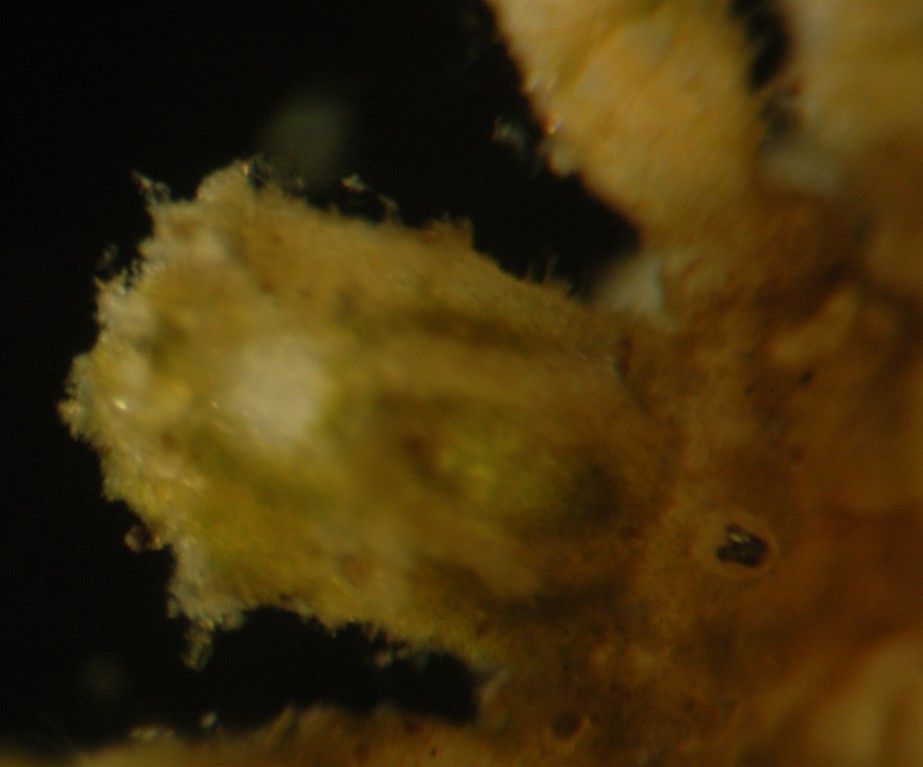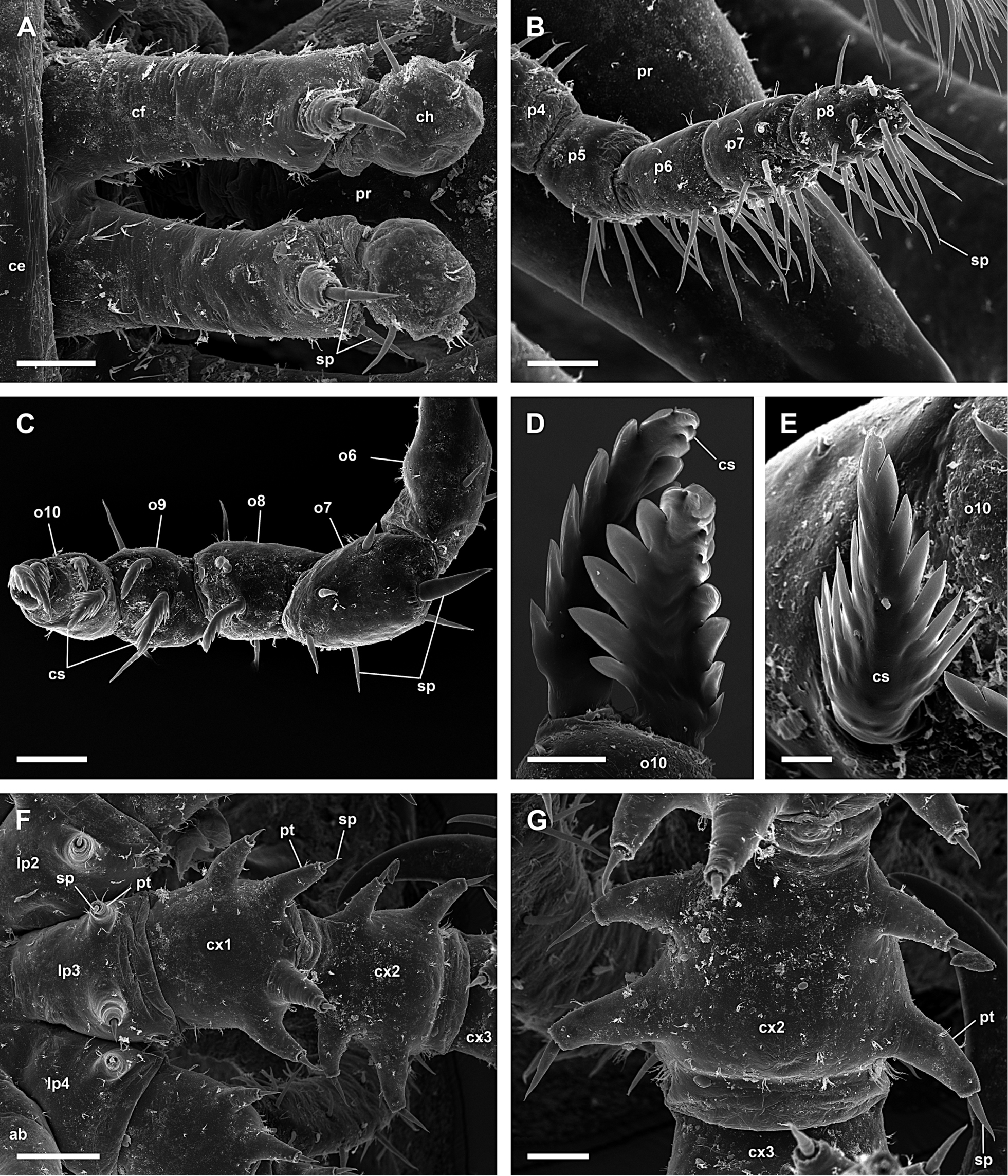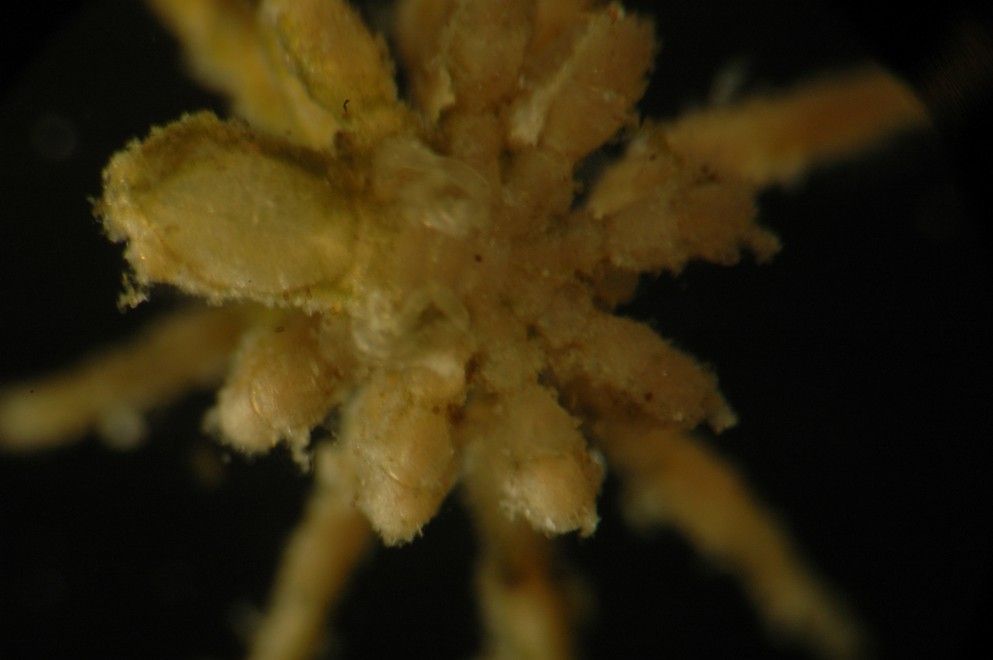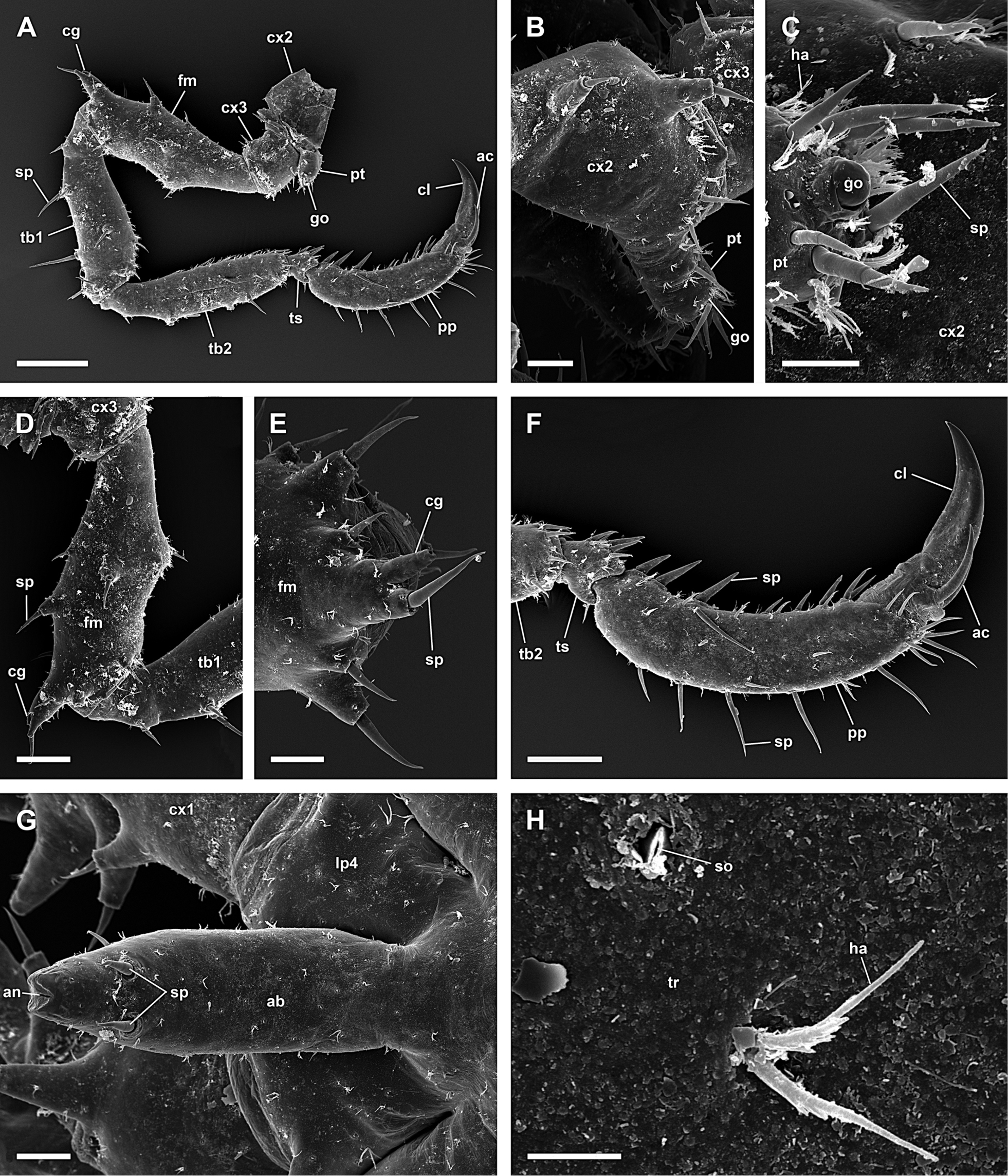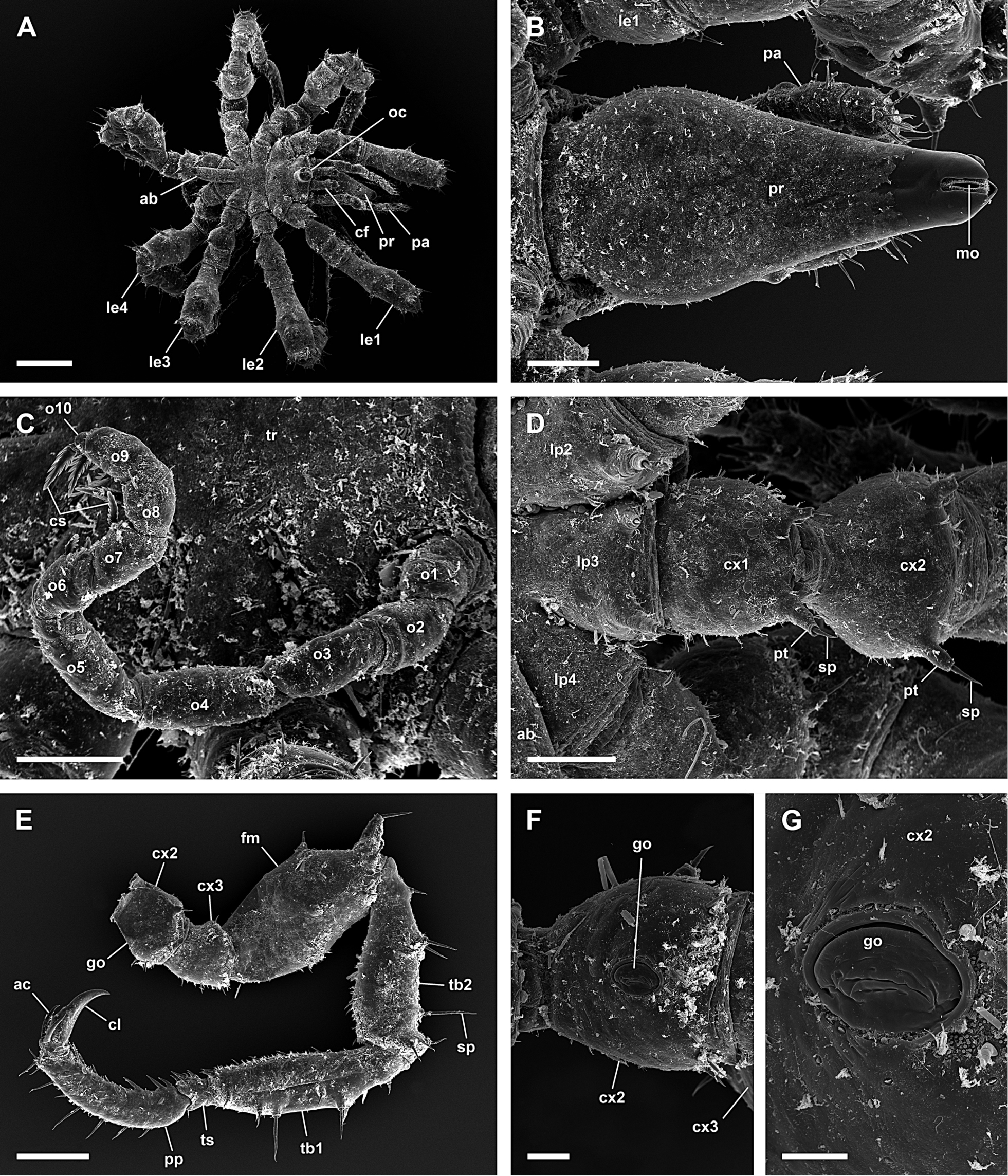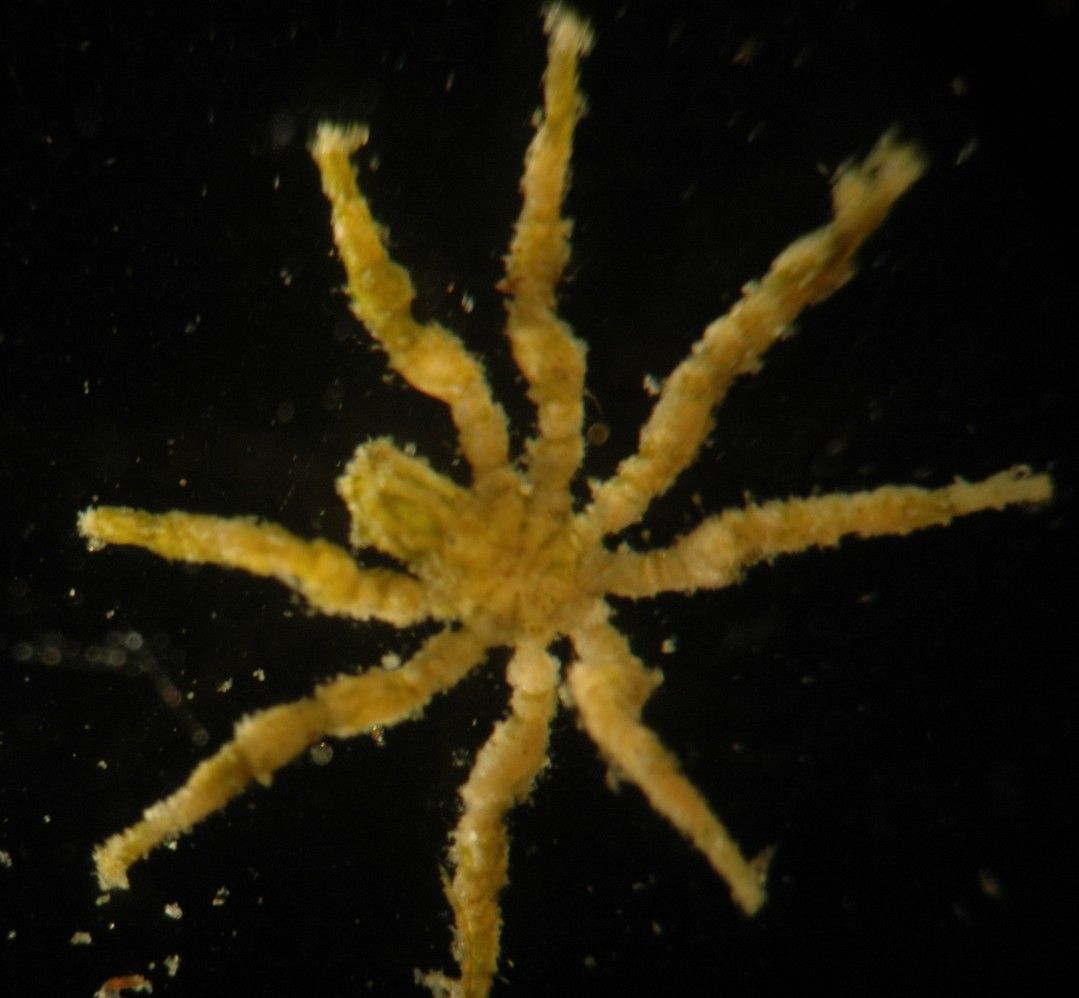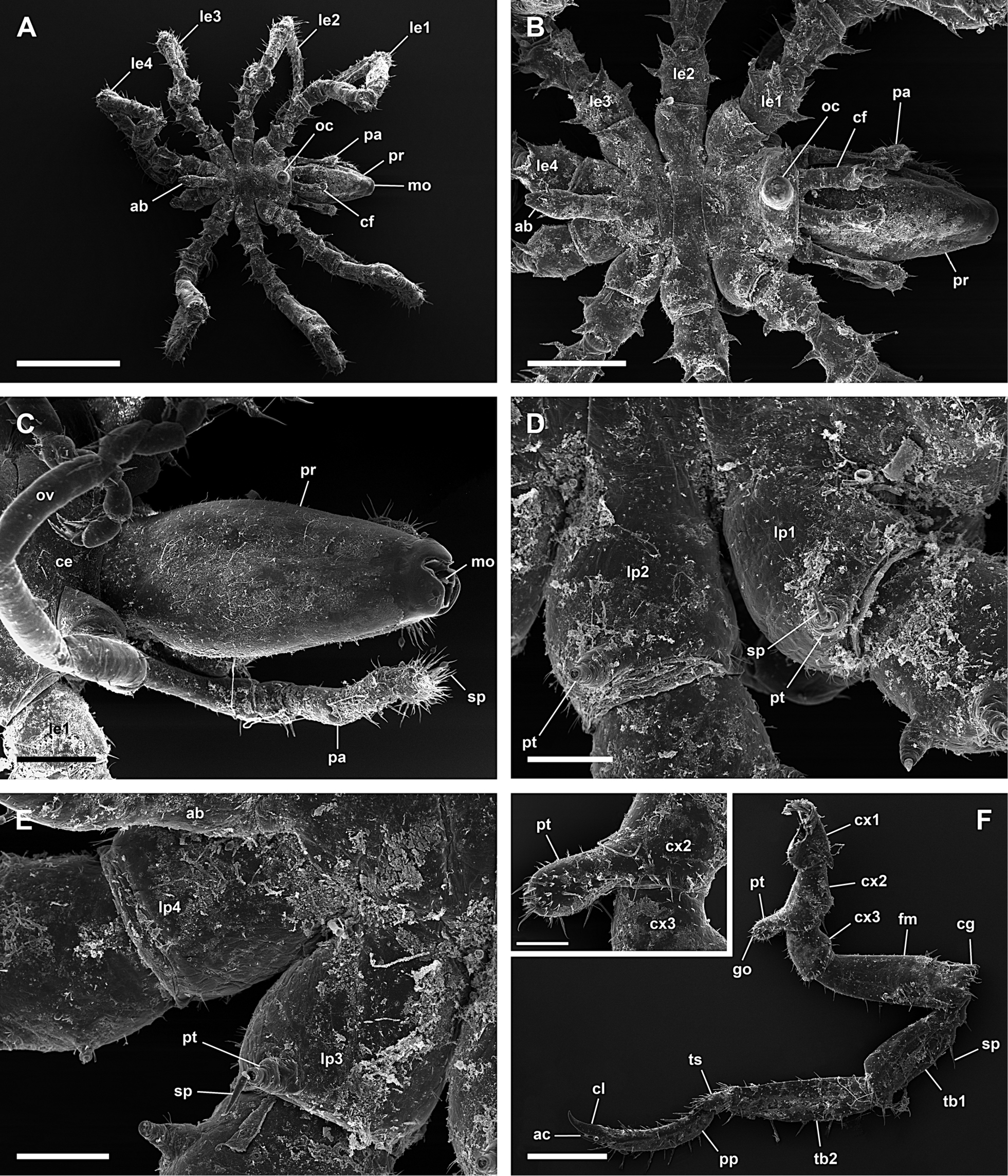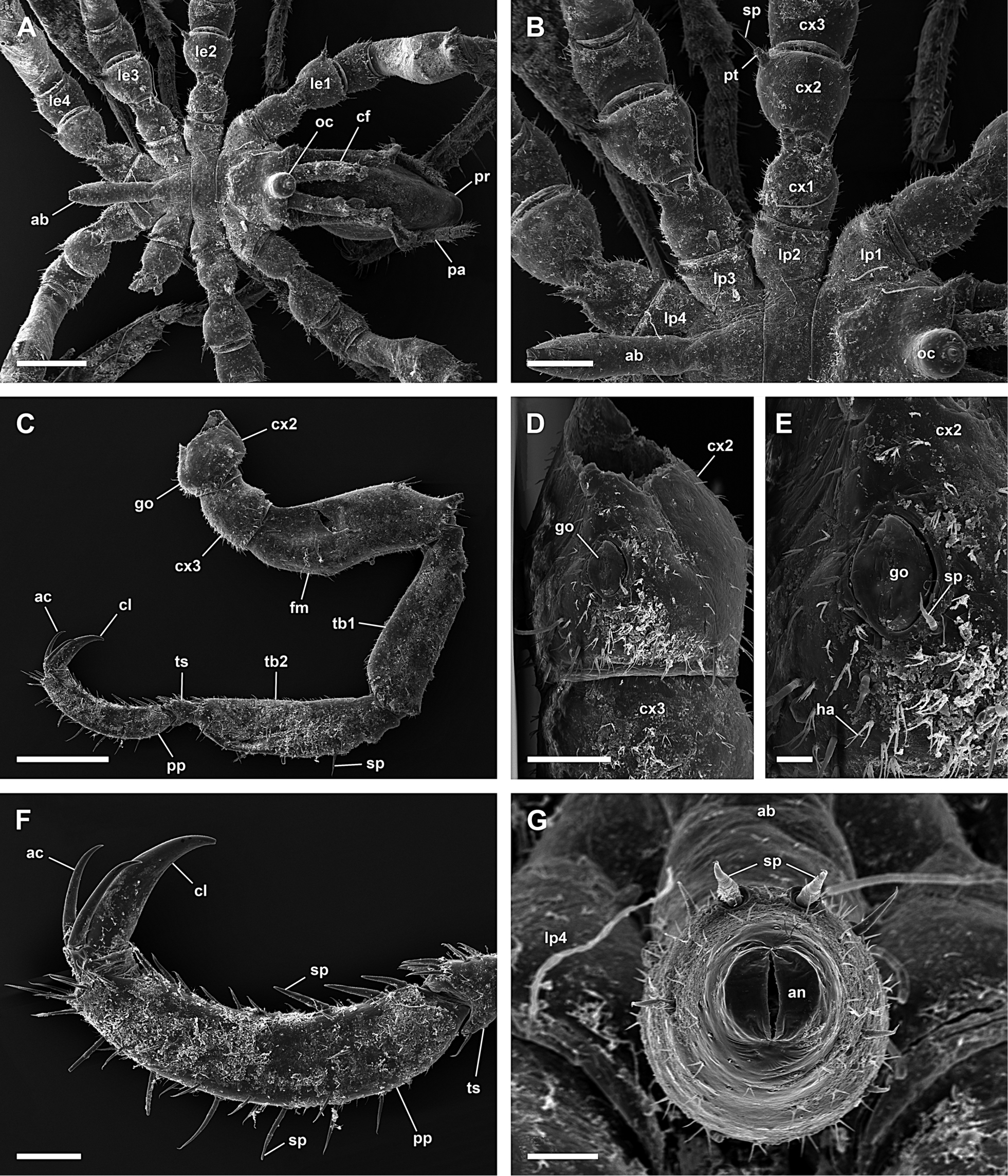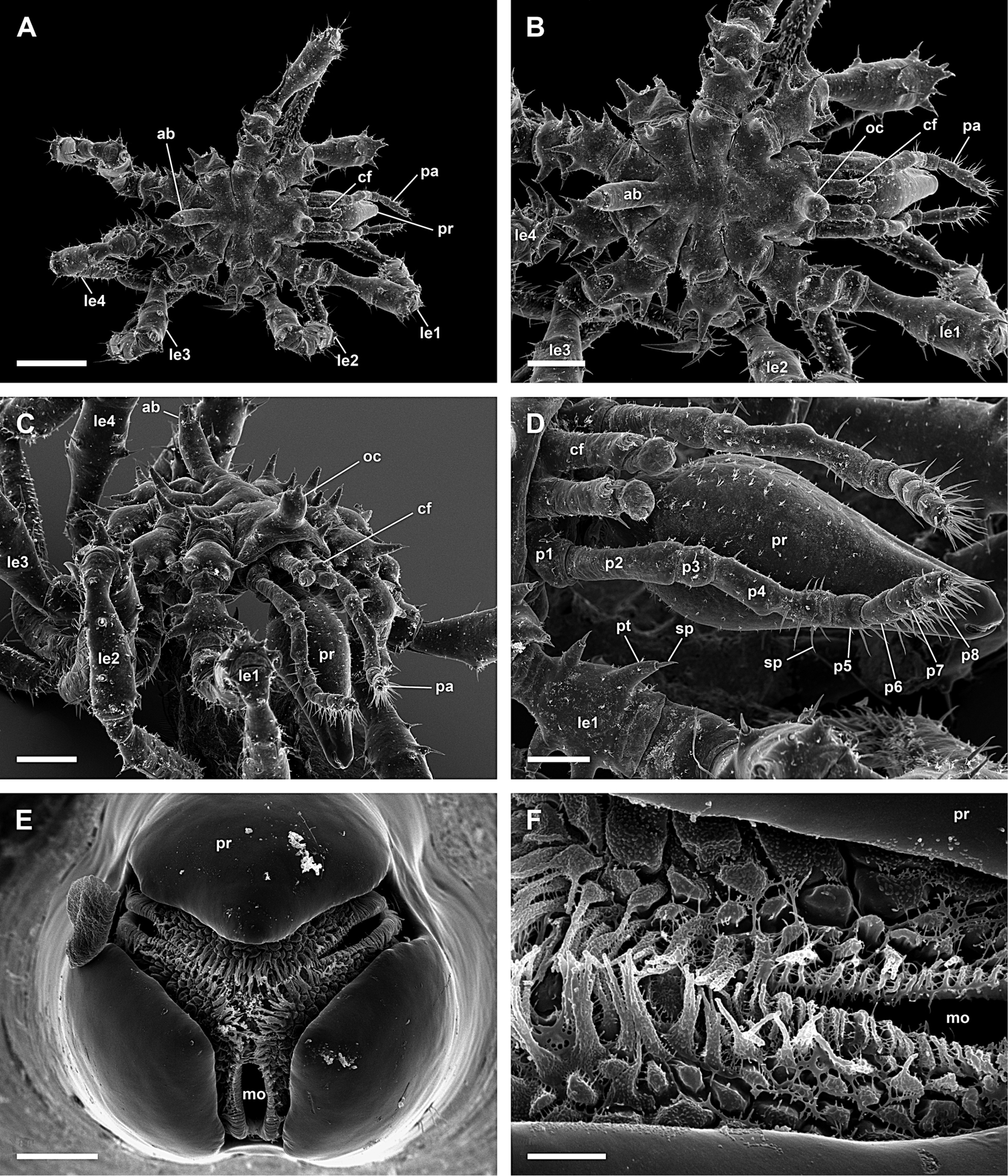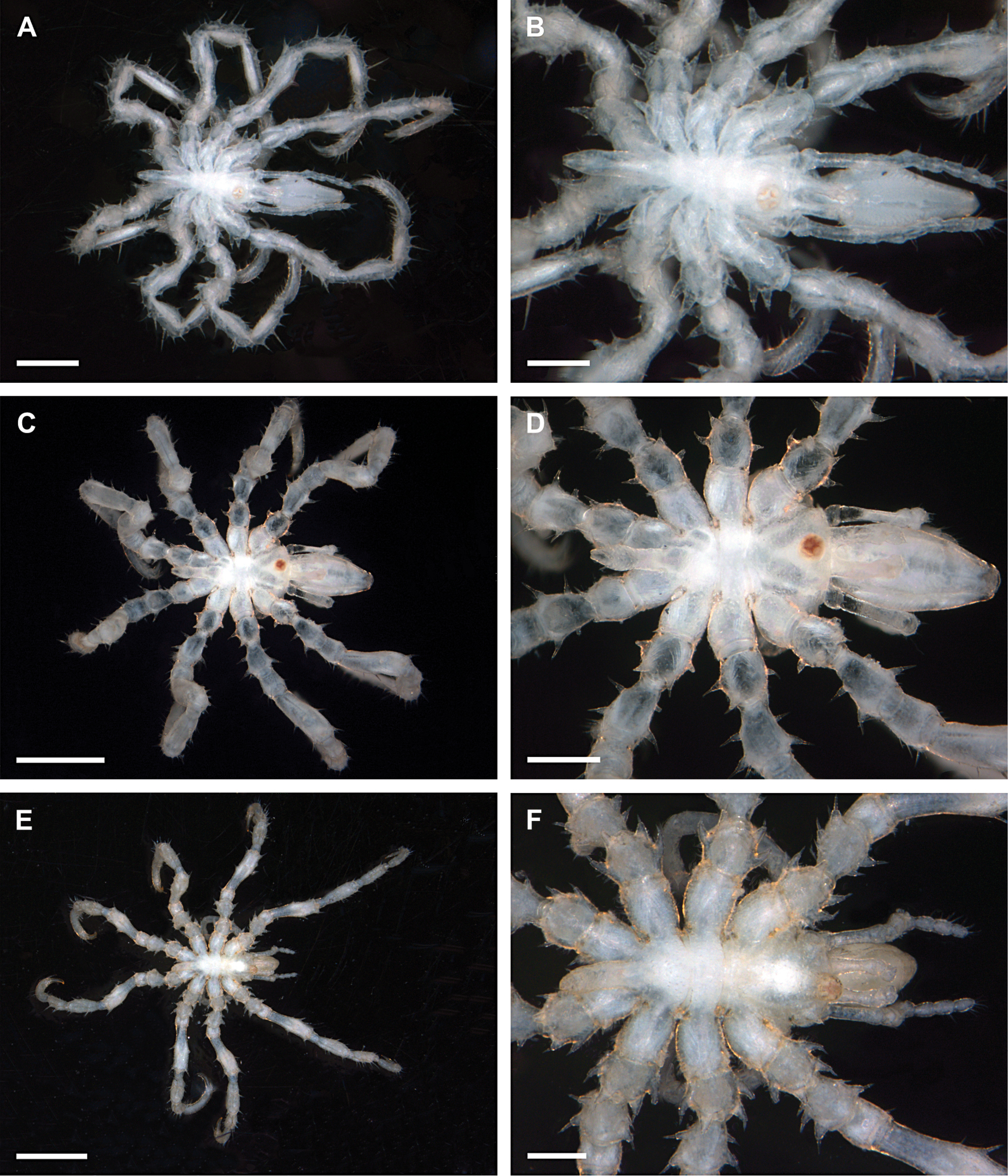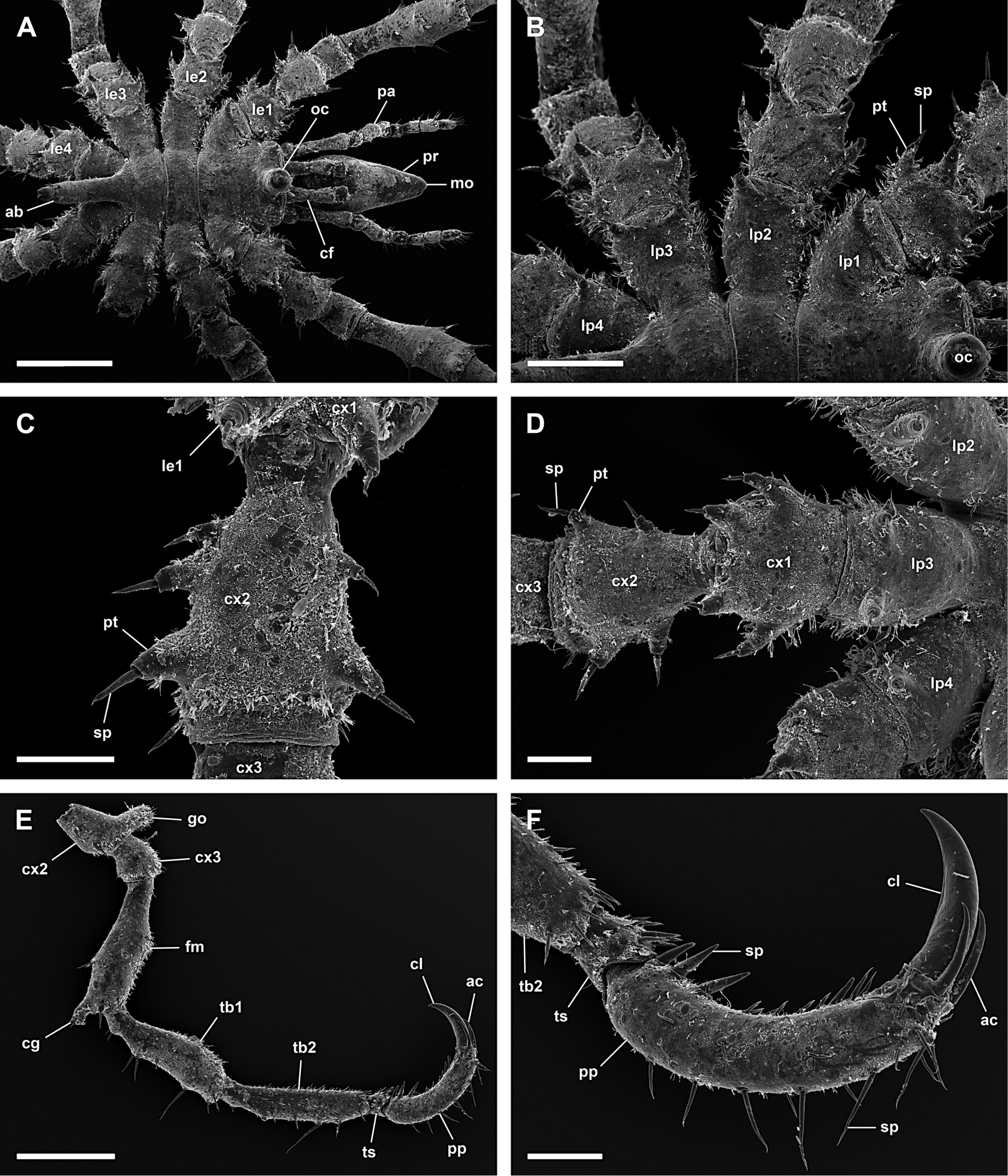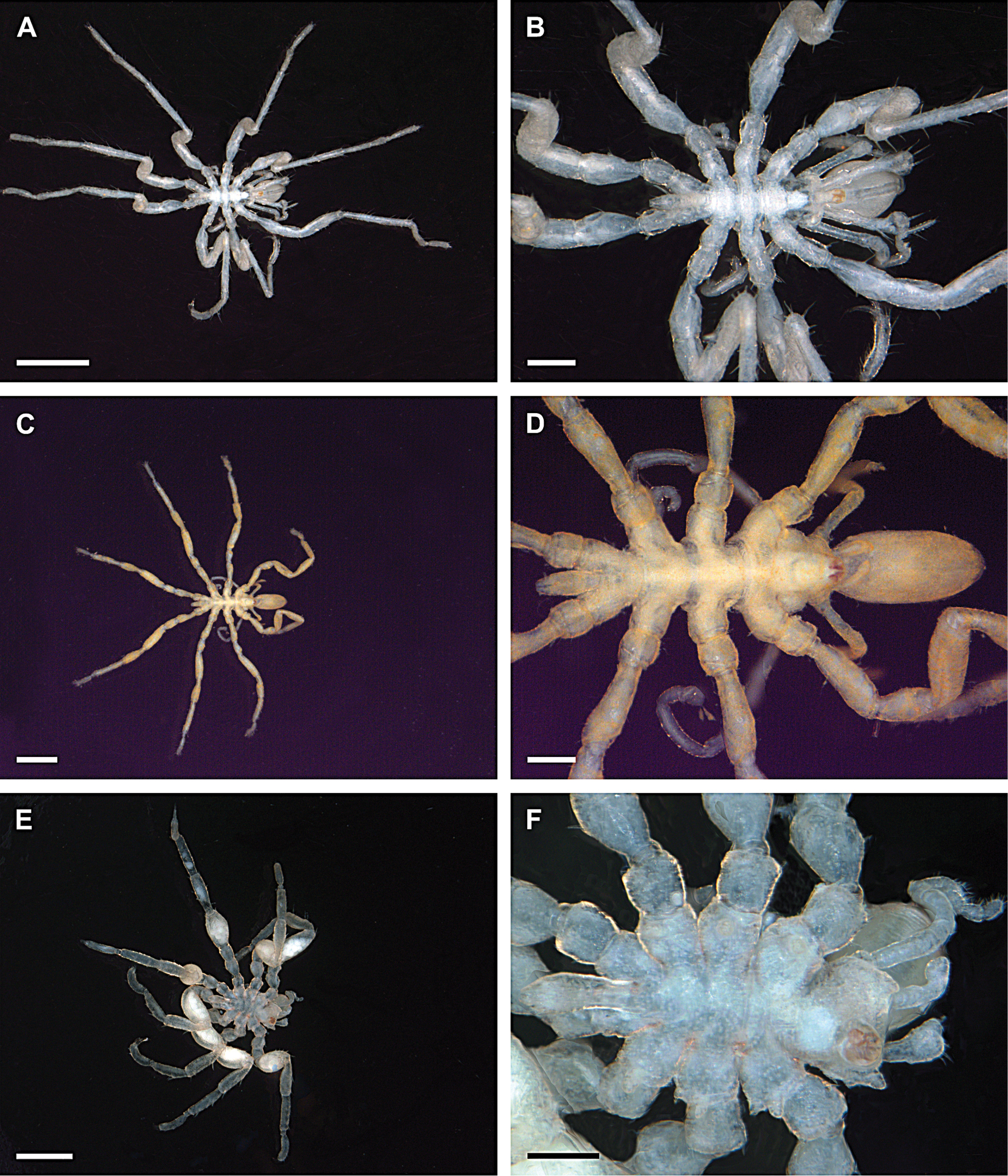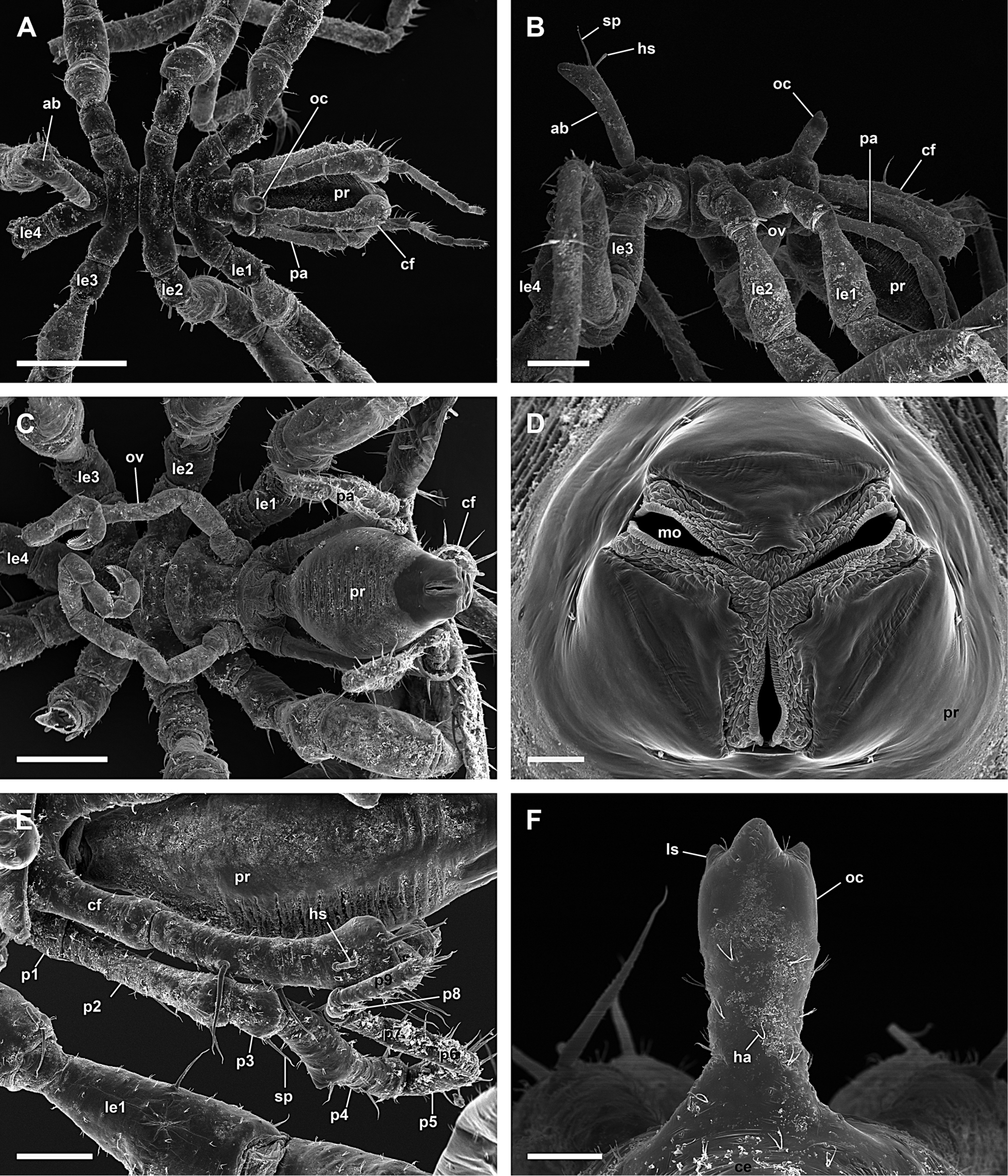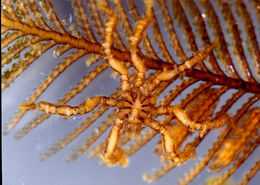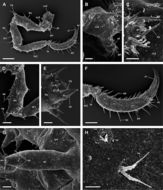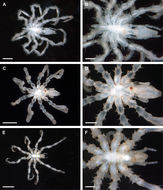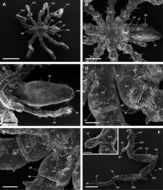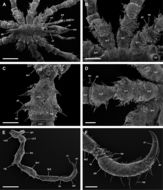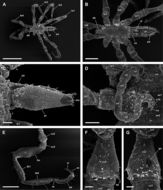-
-
2005 California Academy of Sciences
CalPhotos
Female sea spider on hydroid Aglaophenia latirostris, 8 mm across. Moves very deliberately. Feeds on the hydroid. This individual has lost one leg, but it will not be replaced as these arthropods do not molt.
-
Figure 2.Ammotheidae 1; A, B: Achelia echinata, male, dorsal view; scales 500 µm and 250 µm, respectively; C, D: Achelia langi, male, dorsal view; scales 1 mm and 500 µm, respectively; E, F: Achelia vulgaris, male, dorsal view; scales 1 mm and 250 µm, respectively.
-
This closeup of the head shows the eye turret, the proboscis (top left), the chelicerae (chelifores) next to the proboscis which are two-segmented and end with a knob rather than a chela, the basal segments of the palps, and the coxae of the first several legs. Note that there is no finger-like projection on the dorsodistal part of the coxa of the first leg.
-
In this closeup view one can see the tiny turretlike head with 4 eyes (near the left end of the body, between the left (front) pair of legs). The proboscis is much larger than the head and extends to the left of the body.
-
In this closeup of the posterior body, the stub-like abdomen projecting from the thorax can be seen. Several algal cells are adhered to the leg in the lower right.
-
Here is an even closer view of the turret-like head, which appears as a small tubercle covered with 4 eyes, and also of the proboscis
-
Figure 6.Achelia echinata, male; A: Chelifores with reduced chela; scale 40 µm; B: Distal articles of right 8-articled palp; scale 40 µm; C: Distal articles of 10-articled oviger; scale 40 µm; D, E: Compound spines on last oviger-article; scales 10 µm and 5 µm, respectively; F: Lateral process, coxa 1 and 2 of right 3rd leg, 2 protuberances with spine on each side of coxa 2; scale 100 µm; G: Coxa 2 with 2 protuberances with spine on each side (right 3rd leg); scale 40 µm.
-
Achelia latifrons found on an Epiactis prolifera anemone at Cape Flattery. The distance from the tip of the proboscis (top left) to the tip of the abdomen (bottom right) is 3 mm. Total leg span is 11 mm. (Photo by: Dave Cowles, July 2014)
-
In this ventral view, the small ovigerous legs can be seen on the underside of the first body segment (left side, just to the right of the proboscis). Here the animal is extending its other, walking legs upward and away from the camera. The proboscis is to the left. Females of some families lack ovigerous legs and in other families they are reduced in females.
-
Figure 7.Achelia echinata, male; A: Left 3rd leg; scale 200 µm; B: Lateral view of coxa 2 with genital protuberance (right 4th leg); scale 40 µm; C: Genital opening (right 3rd leg); scale 20 µm; D: Lateral view of femur with cement gland on distal part (left 3rd leg); scale 100 µm; E: Cement gland (right 4th leg); scale 40 µm; F: Tarsus, propodus, and claw, auxiliary claws about half as long as claw (left 3rd leg); scale 100 µm; G: Abdomen; scale 40 µm; H: Hair and slit organ on dorsal side of trunk; scale 5 µm.
-
Pycnogonids are frequently found clinging to hydroids, as here on the hydroid Aglaophenia sp.
-
2005 California Academy of Sciences
CalPhotos
This male sea spider is brooding fertilized eggs he gathered from his mate. The resulting larvae will parasitize the hydroid Aglaophenia on which the adults feed. 8 mm across. These cryptic sea spiders move very slowly.
-
Figure 8.Achelia echinata, female; A: Dorsal view; scale 400 µm; B: Ventral view of proboscis; scale 100 µm; C: Left 10-articled oviger; scale 100 µm; D: Lateral process, coxa 1 and 2 of right 3rd leg, lateral processes touch each other; scale 100 µm; E: Left 3rd leg; scale 200 µm; F: Ventral view of coxa 2 with genital opening, distal is right (left 3rd leg); scale 40 µm; G: Genital opening; scale 20 µm.
-
Tanystylum occidentalis from under an intertidal rock near the S end of Lopez Island. Total leg span about 8 mm. (Photo by: Dave Cowles, July 2006)
-
Figure 2.Ammotheidae 1; A, B: Achelia echinata, male, dorsal view; scales 500 µm and 250 µm, respectively; C, D: Achelia langi, male, dorsal view; scales 1 mm and 500 µm, respectively; E, F: Achelia vulgaris, male, dorsal view; scales 1 mm and 250 µm, respectively.
-
Figure 9.Achelia langi, male; A: Dorsal view; scale 1 mm; B: Dorsal view of trunk; scale 400 µm; C: Ventral view of proboscis; scale 200 µm; D: Dorsal view of right lateral processes 1 and 2, 2 protuberances with spine on lateral process 1 and 1 on lateral process 2; scale 100 µm; E: Dorsal view of right lateral processes 3 and 4, 1 protuberance with spine on lateral process 3 and lateral process 4 without protuberance or spine; scale 100 µm; F: Left 3rd leg; scale 400 µm; insert: Genital protuberance; scale 100 µm.
-
Figure 10.Achelia langi, female; A: Dorsal view of trunk; scale 400 µm; B: Dorsal view of left lateral processes, 1 protuberance with spine on lateral process 1-3, lateral process 4 without protuberance or spine; scale 200 µm; C: Right 3rd leg; scale 400 µm; D: Ventral view of coxa 2 with genital opening, distal is down (right 3rd leg); scale 100 µm; E: Genital opening; scale 20 µm; F: Tarsus, propodus, and claw, auxiliary claws about 2/3 of length of claw; scale 100 µm; G: Abdomen with anus; scale 40 µm.
-
Figure 5.Achelia echinata, male; A: Dorsal view; scale 400 µm; B: Dorsal view of trunk, lateral processes touch each other; scale 200 µm; C: Frontal view of trunk, protuberances with spines on lateral process; scale 200 µm; D: Lateral view of proboscis, palp and chelifores with reduced chela; scale 100 µm; E: Mouth opening, dorsal is up; scale 20 µm; F: Mouth opening; scale 5 µm.
-
Figure 2.Ammotheidae 1; A, B: Achelia echinata, male, dorsal view; scales 500 µm and 250 µm, respectively; C, D: Achelia langi, male, dorsal view; scales 1 mm and 500 µm, respectively; E, F: Achelia vulgaris, male, dorsal view; scales 1 mm and 250 µm, respectively.
-
Figure 11.Achelia vulgaris, male; A: Dorsal view of trunk; scale 400 µm; B: Dorsal view of left lateral processes, lateral processes do not touch each other; scale 200 µm; C: 2 protuberances with spine on right side and 3 on left side of coxa 2, distal is down (right 1st leg); scale 100 µm; D: Lateral process, coxa 1 and 2, 2 protuberances with spine on each side of coxa 2 (left 3rd leg); scale 100 µm; E: Right 3rd leg; scale 400 µm; F: Tarsus, propodus, and claw, auxiliary claws about half as long as claw; scale 100 µm.
-
Figure 12.Achelia vulgaris, female; A: Dorsal view; scale 1 mm; B: Dorsal view of trunk, lateral processes do not touch each other; scale 300 µm; C: Ventral view of proboscis; scale 100 µm; D: Right 10-articled oviger; scale 100 µm; E: Right 3rd leg; scale 400 µm; F: Dorsal view of coxa 2 (left 3rd leg); scale 40 µm; G: Ventral view of coxa 2 with genital opening (left 3rd leg); scale 40 µm.
-
Figure 3.Ammotheidae 2; A, B: Ammothella appendiculata, female, dorsal view; scales 1 mm and 250 µm, respectively; C, D: Ammothella biunguiculata, male, dorsal view; scales 1 mm and 250 µm, respectively; E, F: Ammothella longipes, female, dorsal view; scales 1 mm and 250 µm, respectively.
-
Figure 13.Ammothella appendiculata, female; A: Dorsal view of trunk; scale 400 µm; B: Lateral view of trunk; scale 200 µm; C: Ventral view of trunk; scale 200 µm; D: Mouth opening, dorsal is up; scale 20 µm; E: Right chelifore with reduced chela and right 9-articled palp; scale 100 µm; F: Ocular tubercle with lateral sense organ; scale 40 µm.


